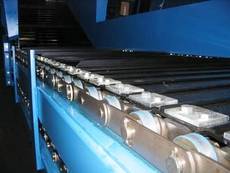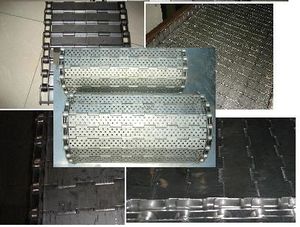Difference between revisions of "Steel Plate Conveyors"
(Created page with "Category:Conveying{{Knoppen}} <noinclude><!------------------------------------------------ * READ THIS FIRST * Only edit this page if you can improve the content. * Imprope...") |
|||
| Line 7: | Line 7: | ||
* Please start editing this page after the /noinclude | * Please start editing this page after the /noinclude | ||
* -------------------------------------------------></noinclude> | * -------------------------------------------------></noinclude> | ||
[[File:Steel plate conveyor2.jpg|thumb|right|Steel Plate Conveyors]] | |||
[[File:Steel plate conveyor.jpg|thumb|right|Steel Plate Conveyors]] | |||
'''Steel Plate Conveyor''' is used under the toughest of conditions, for example in the scrap and recycling industry or in quarries, for discharging, transportation and dosing. | |||
A curve traveling steel plate conveyor comprises a plurality of conveyor plates with a series of interconnecting chain links flexibly interconnecting the conveyor plates. Structure is provided for guiding the conveyor plates over a path of travel that includes a curved segment. A drive for the conveyor plates includes a driven conveyor belt below the conveyor plates in frictional engagement with the conveyor plates at least over a selected portion of the path of travel of the steel plate conveyor. | |||
The steel plate conveyor is exposed to extreme loading: boulders weighing many tons are discharged into the feed hopper by a loader, compressed scrap vehicles and heavy metal parts are loaded onto the steel slats using crane claws and must be conveyed. On especially heavily loaded positions, such as e.g. in the discharge areas, so-called impact rails are used that help to absorb the blows. | |||
In many applications, the steel plate conveyor is used for feeding crushers (rock and stone) or shears and shredders (metal recycling); thereby, a constant flow must be ensured. Using frequency-controlled drives, the conveyance speed of the steel plate conveyor can be coordinated with the machine downstream. | |||
Latest revision as of 21:45, 27 August 2012
Steel Plate Conveyor is used under the toughest of conditions, for example in the scrap and recycling industry or in quarries, for discharging, transportation and dosing.
A curve traveling steel plate conveyor comprises a plurality of conveyor plates with a series of interconnecting chain links flexibly interconnecting the conveyor plates. Structure is provided for guiding the conveyor plates over a path of travel that includes a curved segment. A drive for the conveyor plates includes a driven conveyor belt below the conveyor plates in frictional engagement with the conveyor plates at least over a selected portion of the path of travel of the steel plate conveyor.
The steel plate conveyor is exposed to extreme loading: boulders weighing many tons are discharged into the feed hopper by a loader, compressed scrap vehicles and heavy metal parts are loaded onto the steel slats using crane claws and must be conveyed. On especially heavily loaded positions, such as e.g. in the discharge areas, so-called impact rails are used that help to absorb the blows. In many applications, the steel plate conveyor is used for feeding crushers (rock and stone) or shears and shredders (metal recycling); thereby, a constant flow must be ensured. Using frequency-controlled drives, the conveyance speed of the steel plate conveyor can be coordinated with the machine downstream.

